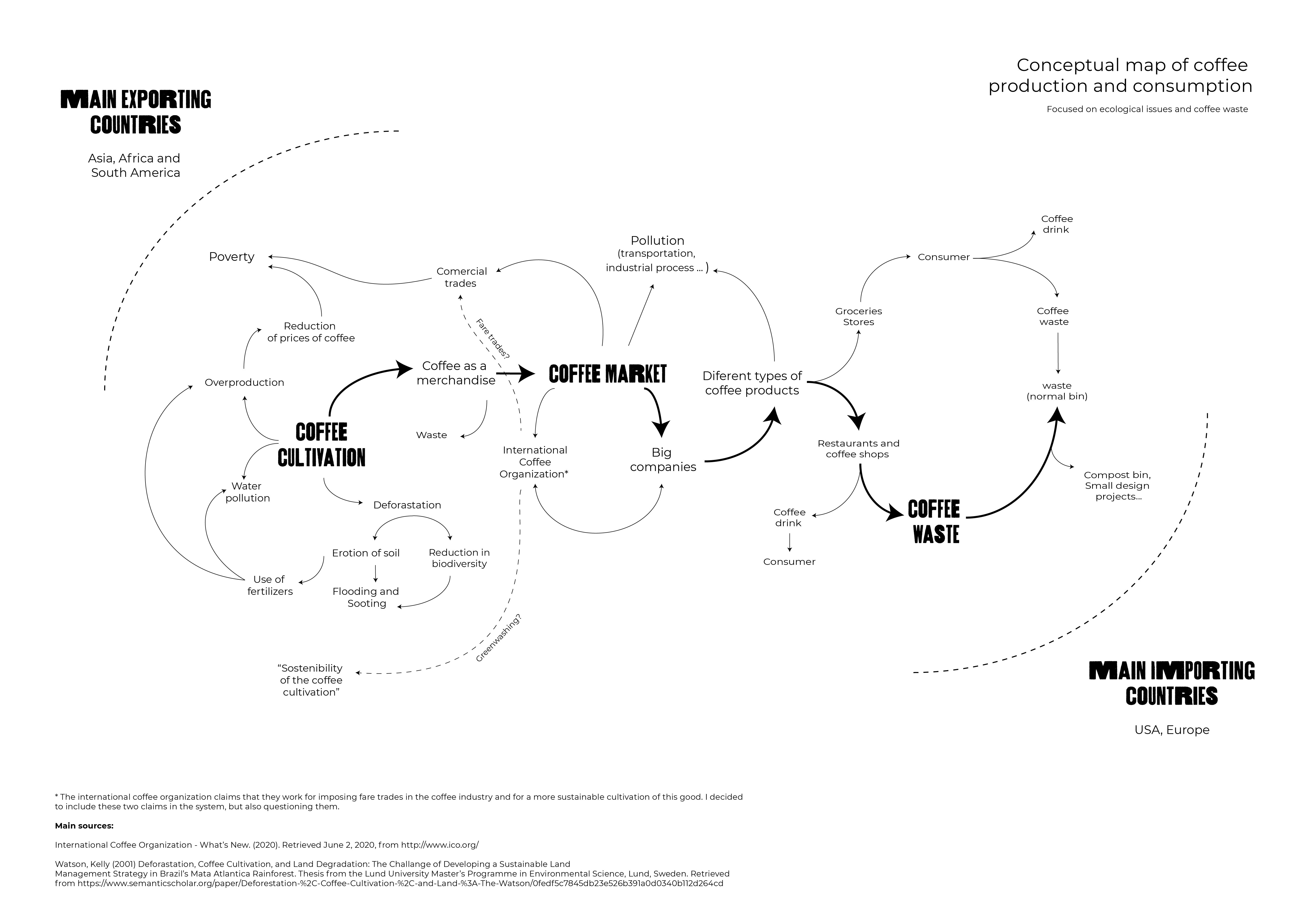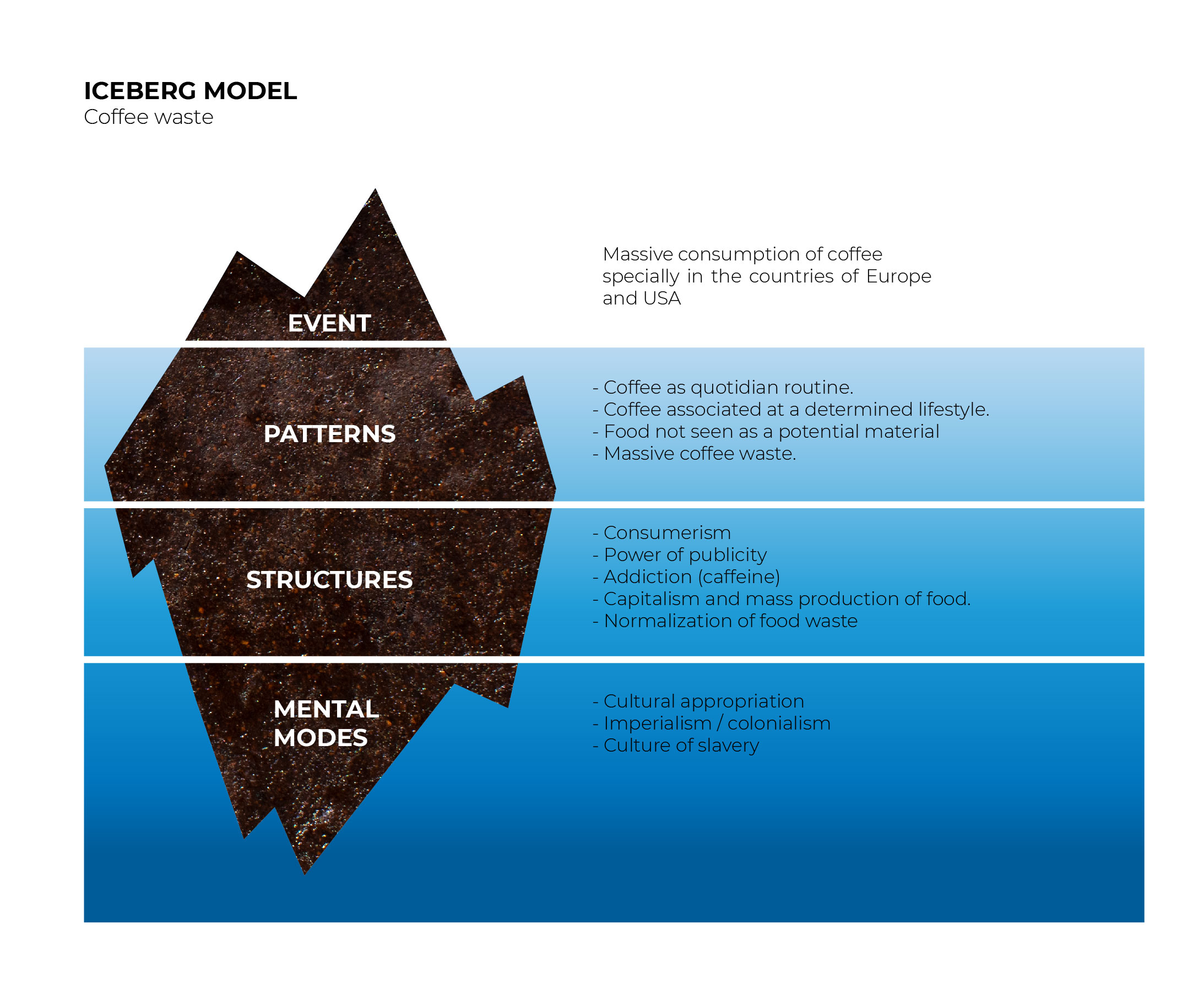Back to
main page


The coffee industry is one of the biggest industries in the world. In the observatory of economic complexity, they rang coffee as the world’s 121st most traded product (1)* in 2018. Yearly the world consumption of coffee is about 165 269 thousand of bags of 60 kgs.(2) There is a big geographical difference between countries that produce and consume this good. The first ones are majorly located in Africa, South America and Asia while the consume is larger in USA and European countries. (3)
Some of the major problematics are the ecological problems and effects on the biodiversity produced during the farming process of this good (4), and the waste after the consumption. Due to the historical and geographical difference between who consume and produce this food and the economic interest behind it, there are a lot of other social and economic problematics surrounding it. These are related to the exploitation of not only nature but also people who work in the first steps of the industry.
As it is said in the article on Bioregioning (5) social change design focused on ecology has the power of seeing pattern of life. The importance that western culture to reconnect with nature and place. This concept is closely related to y design concept as it tries to establish a new connection between waste and human life through the design on furniture for public spaces.
In the paper best of Both worlds: A critical pedagogy of Place6 as talking about Eco-justice they mention four focuses that I was able to easily connect while digging into the coffee industry. Such as understanding the relationship between ecological and cultural systems, the domination of nature and oppressed groups, the geographical dimensional injustice and environmental pollution, among others.
After researching about my topic and getting a broad perspective of the different problematics I tried to identify and develop where I could focus my design project. For this design proposal I decided to focus in the last steps of the coffee consumption chain, the waste that is produced after making coffee. Used coffee grounds and coffee waste in coffee shops and restaurants that go directly to the bin.
As the coffee waste is a natural material and can be used without any transformation in fertilizing the soil or in mushroom farms, I did not want to change this property in the research of a new material. I found the path in the cooking books of new materials and bioplastics.
My design concept pretends to use this waste to create a new material that can be used in the public space as urban furniture. This proposal is only a small approach to a systemic and broad problematic, to make notorious the importance of seen waste as potential new material. What happened after the life of this new object was another aspect important during the thinking of this project.
Bibliography
1.The observatory of economic complexity – Coffee (2019). Retrieved June 5, 2020, from https://oec.world/en/profile/hs92/coffee
* Author Note (presentation correction): As you search for coffee industry on internet, you find the claim that is “the second most important industry behind oil” in many articles. I tried to find a valid source for that statement, but I could not find one. I research on some databases like in the observatory of economic complexity and they rang it as the 121st which proves that is still a big and important good but as not shocking as my first statement. But it seems to be more reasonable, I correct then here my statement on my presentation which was more likely to be false.
2. International Coffee Organization – Trade Statistics Tables (2020). Retrieved June 2, 2020, from http://www.ico.org/
3. International Coffee Organization - Historical Data on the Global Coffee Trade. (2020). Retrieved June 2, 2020, from http://www.ico.org/
4. Watson, K. (2001) Deforestation, Coffee Cultivation, and Land Degradation: The Challenge of Developing a Sustainable Land Management Strategy in Brazil’s Mata Atlantica Rainforest. Thesis from the Lund University Master’s Programme in Environmental Science, Lund, Sweden. Retrieved from https://www.semanticscholar.org/paper/Deforestation-%2C-Coffee-Cultivation-%2C-and-Land-%3A-The-Watson/0fedf5c7845db23e526b391a0d0340b112d264cd
5. Thackara, J. (2019) Bioregioning : Pathways to Urban – Rural Reconnection. Doors of Perception. Tongji University Press, France.
6. Gruenewald, D. A. (2003). The Best of Both Worlds: A Critical Pedagogy of Place. Eductional Researcher, 32(4), 3–12. Retrieved from http://links.jstor.org/sici?sici=0013-189X%28200305%2932%3A4%3ATBOBWA%3E2.0.CO%SB2-J
Other sources
Beyene, A., Kassahun, Y., Addis, T. et al. (2012) The impact of traditional coffee processing on river water quality in Ethiopia and the urgency of adopting sound environmental practices. Environ Monit Assess 184, 7053–7063. Retrieved from https://doi.org/10.1007/s10661-011-2479-7
Nuetzenadel, A; Trentmann, F.(2008) Food and Globalization: Consumption, Markets and Politics in the Modern World. Oxford Berg. Pg 109-122. Retrieved from: https://books.google.es/books?id=ScmvAwAAQBAJ&pg=PA111&lpg=PA111&dq=introduction+to+coffee+in+europe+colonization&source=bl&ots=vL0QGkJ4qs&sig=ACfU3U0ahaJRFtRZNEzE5w2XeLiVzSQV0A&hl=ca&sa=X&ved=2ahUKEwjx9dOwttHpAhXIasAKHe9kBlsQ6AEwG3oECAgQAQ#v=onepage&q=introduction%20to%20coffee%20in%20europe%20colonization&f=false
Haggar, J. (2011) Coffee and Climate Change. Desk Study Impact of Climate Change in four Pilot Countries of the Coffee & Climate Initiative. University of Greenwich & Kathleen Schepp, London, United Kingdom.